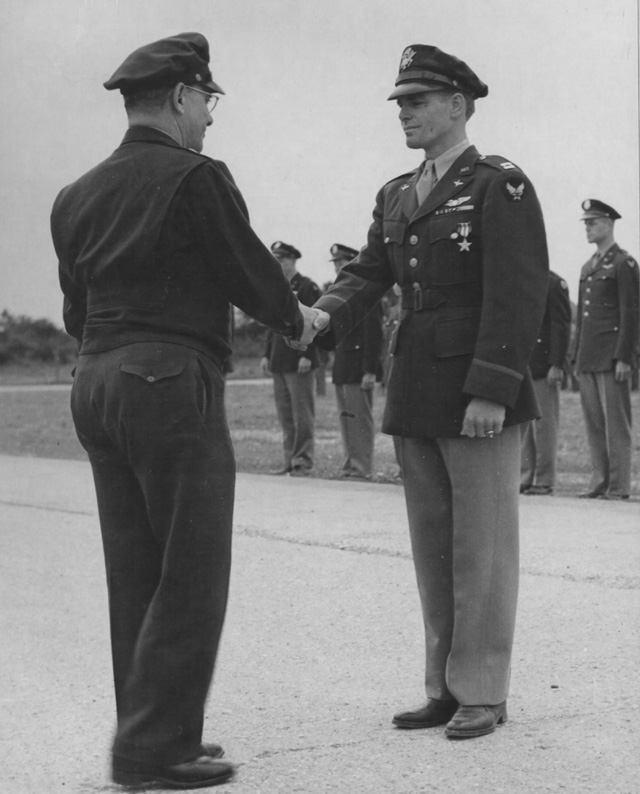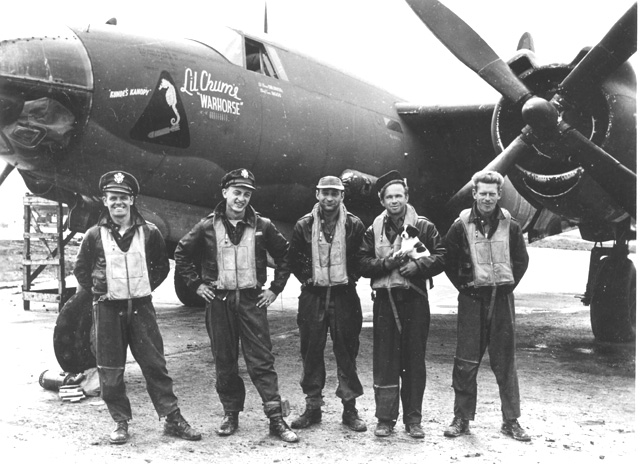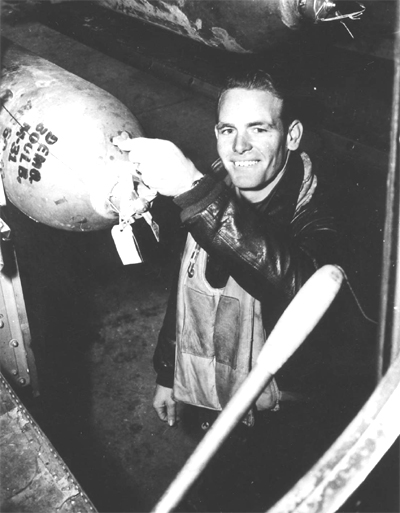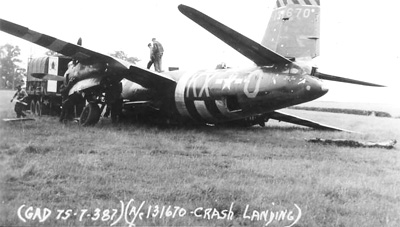|
|
Guest Book | Pages & Links |
Rollin D. Childress, Pilot
42-H Ellington
387th Bomb Group, 558th Bomb Squadron
From Enlisted Sergeant Pilot to Lt. Colonel

Capt. Rollin D. Childress, 911 So. Ohio Ave., Etowah, Tenn., is congratulated by Lt. General Lewis H. Brereton, Commanding General of the 9th Air force, who presented him with the Silver Star in ceremonies at a Martin B-26 base in the ETO. France.
An Account of the Mission of 8th June, 1944 to Foret De Grimbosq
(Editors comment: This is the fifth article in a series about the 558th Bomb Squadron Crews who flew or serviced the B-26 Aircraft named “Wham Bam”. T/Sgt. Robert M. Nelson was the Ground Crew-Chief who serviced the aircraft from the beginning to the end. We read his story last time. D-Day was June 6, 1944, the invasion of the Normandy beaches and the first time Allied Soldiers stepped ashore on the European Continent. It was the beginning of the defeat of Hitler and his German Armed Forces. On June 8, 1944 (just two days after the invasion) this story takes place, because of the urgent and immediate need to destroy an important fuel dump for German tanks in a forest in Normandy. Lt. William Weise and his crew were flying “Wham Bam” on this mission. The original pilot was Capt. Robert Harmon. He and his crew had flown the aircraft on the Northern Route to England. On May 29, 1944 while on a mission to the Conflans RRY Bridge near Paris, Capt. Harman and crew were flying a new replacement aircraft and were shot down. He was not flying his usual “Wham Bam”.
At 1900 hours of 8 June 1944 the crews of 18 airplanes were gathered together at Chipping Ongar Airfield and hastily briefed. The target was given to them as coordinates in the woods (forest). The importance of destroying it was stressed very strongly. The target, in the Foret de Grimbosq lying 9 miles south of Caen (on the Normandy Peninsula), was the fuel dump supplying a Panzer Division, which at that moment was bringing great pressure to bear on the beachhead in the Caen area. The destruction of this fuel dump would materially aid the efforts of the Allied troops on the beachhead. To give urgent and direct support of the allies beachhead on Normandy, the success of this mission was vital.
In spite of ominous clouds covering the field in a 10/10th layer at 900 feet and obscuring visibility to I to 2 miles, Captain Rollin D. Childress (558th) was formation leader and 17 Marauders behind him took off in the gathering darkness at 1958 hours. The formation circled the field once at 800 feet and headed south. As they left the field onlookers from the ground saw the formation start up through the overcast. In an instant, the entire formation was swallowed up in the overcast. One airplane returned almost immediately with engine trouble. Captain Childress assembled three airplanes behind him. The other 12 airplanes while fanning out to come up through the overcast became utterly lost. They groped about looking for the formation without success, finally were forced to return to the base. On returning, many reported it to be the worst weather they had ever flown in. One aircraft was unable to find the home field and due to the low visibility overshot the field at Gravesend and crash-landed without injuring the crew. Another airplane attempting to land in almost zero visibility at Friston crashed and killed five of the crew and seriously injuring the sixth man.
In the meantime, Captain Childress with 3 other airplanes, piloted by 1st Lt. William N. Wiese (558th), 1st Lt. Dewitt E. Tyler and Captain Charles W. Schober (558th) respectively, found a space between two strata of clouds at 4500 feet and continued southward. The space between the clouds came to an abrupt end and Captain Childress was forced to descend through the overcast in search of an open space. Hopping from hole to hole Captain Childress went all the way down to the ground without finding an open space. It was a credit to all four pilots that they managed to stay together.
The formation crossed the English Coast at Brighton dead on course. They crossed on the deck with ceiling zero and visibility % mile. Crewmembers reported they could look up to see the knolls of the low-lying rolling hills. Continued rainsqualls beat against the windscreens lessening what little visibility there was.
It was at this point that Captain Childress radioed IX Bomber Command. He reported the ceiling zero, visibility one half a city blocks, and his formation on the deck. He asked for instructions but received no answer. Again he called in for instructions and received no answer. In the absence of instructions, he continued on.
The facts were that IX Bomber Command issued a general recall to all Groups. Six Groups comprising 222 airplanes heard the recall and returned to their bases. Captain Childress did not hear the recall and drove steadily onward.
The formation came suddenly upon a convoy just off the English Coast and weaved through its barrage balloons. A second convoy was encountered shortly after the first and the formation roared over it at 150 feet, Bring the last of its precious colors-of-the-day.
Captain Childress weighed the odd; it was likely that cloud cover would force him to bomb at 2000 feet or less and at that altitude light flak along the route would be a menace; with only four airplanes, his flight would have all too little fire power to ward off any enemy aircraft bouncing them from the excellent cover provided by the low lying clouds above; it was certain that they would have to face further convoys and warships off the beachhead with no colors-of-the-day with which to identify themselves; and it was certain they would have to cope with flying weather made even more dangerous by 2 hours more darkness on their return trip across England to the field. Against these deadly serious hazards, Captain Childress balanced the importance of the target to the men on the beachhead. He continued.
Preparations were made to bomb at low level. Captain Childress’s bombardier, 1st Lt. Wilson J. Cushing, dismounted the Norden bombsight and replaced it with the D-8 sight.
The formation managed to spot another convoy and skirt it without being fired upon. A large warship was also skirted successfully.
Several miles from the French coast the ceiling lifted fortunately and the visibility improved. The formation managed to work its way up to 6,000 feet and crossed the beachhead.
Light flak was encountered before the target was reached but it did not amount to much. The woods in which the target lay was sighted, a forty second run was made and bombs were away at 2116 Vi hours. The crews reported that the bombing was excellent and that a column of smoke several thousand feet high towered up as they turned off the target. Unfortunately there was a malfunction in the only camera in the flight and there is no photographic evidence to bear witness to the testimony of the crews that the target was destroyed.
As they turned off their bomb run, the four airplanes were engaged by moderate, extremely accurate heavy flak. The first burst scored a direct hit on the #4 plane piloted by Captain Charles W. Schober. The shell apparently penetrated the fuel tanks for the airplanes were seen to explode and disintegrate. No parachutes were observed.
The remaining three airplanes continued on through the murderously accurate flak, #3 piloted by Lt. Tyler receiving damage from flying fragments.
Crossing the beachhead they returned across the channel, carefully circumventing several convoys and numerous naval vessels.
Arriving back over England the flight found that visibility had improved only very slightly. Ceiling over the field was 400 feet and visibility one half mile. The three airplanes managed to find the Held in the dark and with the aid of many mortar bombs and flares finally touched down at 2230 hours.
At Interrogation the pilots and crews of the two ships on Captain Childress’ wings expressed profound respect for his resourceful flying and superb leadership. Group Commander Lt. Col. Thomas M. Seymour congratulated the crews heartily and the following morning the Commanding General of 98th Combat Wing, Colonel Millard Lewis personally telephoned Captain Childress and congratulated him on his courage and tenacity in persevering through such trying and dangerous conditions to bomb and destroy the target.
Headquarters: Stanley M. Rowe, Jr.
387th Bombardment Group (M) Capt., AC, Interrogating Intelligence Officer
POSTSCRIPT 13 JUNE 1944
The following excerpt from Headquarters IX Bomber Commands “Intelligence
Operations Report” dated 13 June 1944:
The attack on the ammunition and fuel dump at Foret de Grimbosq is also reported
by the Army to have been exceptionally successful. Destruction of immediate
reserves for the enemy armored units operating in the area permitted the ground
forces to make progress which otherwise might have been difficult and costly.
In regard to these two attacks (the other attack referred to was made on Isigny by the 391st and 322nd Groups) the following message has been received from the 21st Army Group:
“THANKS FROM THE GROUND FORCES TO 391st AND 387™ BOMB GROUPS OF IX BOMBER COMMAND FOR EXCELLENT BOMBING AND SUPER-FLYING IN CEILING ZERO WEATHER”.
The Only Aircraft To Have Attacked FORET de GRIMBOSQ Were Captain Childress’ Four Airplanes.
MISSION SUCCESSFUL!
Captain Childress was congratulated on his tenacity and perseverance by Colonel
Willard Lewis, Commander of the 98th Combat Wing and the 387th Group Commander
Lieutenant Colonel Thomas H. Seymour. CAPTAIN CHILDRESS WAS AWARDED THE SILVER
STAR FOR THIS MISSION.
T/Sgt. Howard Weingrow Radio-Gunner on Capt. Childress’s crew: “This was only my 4th Mission and I thought that it was unlikely I would survive 46 more. The limit was 50 Missions at that time but then it was raised to 65 Missions because there was a shortage of replacement crews.
I was awarded the DFC on this mission for hooking up a Litmus lamp and continuously signaling the code of the day at the rear waist window as we flew low level over the ships in the channel on our return trip to Chipping Ongar. They may never have identified us as a friendly aircraft since my radio was destroyed by enemy fire, (and we had exhausted our colors of the day flares) it seemed the best alternative. Prior to this mission, I always declined the shot of Bourbon since I had never had a drink stronger than wine before. However, my drinking habits changed that very day. I had two shots after the mission followed by a few more and then some Calvados in town”. (Editors note: Howard finished his 65 Missions and was a successful businessman and has been active in many charitable organizations).
(Years later, Captain Stan Rowe, Jr. sent a personal note to 1st
Lt. William N. Wiese (558th)
“All of you should have gotten a Silver Star or Double DFC’s for this mission”
Stan Rowe (Captain, Interrogating Intelligence Officer)
From 559th history book: "On June 7th 1944, it was learned that
the 17th German Panzer Division was moving north to the Invasion beachhead. The
report called for a mission to deny this route to the Germans. Because of bad
weather the formation attempting to bomb the rail junction at Rennes was not
successful, but it did get good results on a railroad west of Vire and on a
choke point of vehicles near St. Lo. The next morning a highly successful
mission was flown against the railroad junction at Pontaubault. The best strike
was made by Lieutenant Donald Tall, bombardier in Captain Robert H. Will's
flight, whose bombs hit the target perfectly.
From Alan F. Crouchman: The afternoon mission proved to be one of the roughest
and most remarkable ever flown by the Group. Captain Rollin D. Childress was to
lead eighteen aircraft to a fuel dump in the Foret de Grimbosq, south of Caen.
At the take-off at 1958 hours the ceiling was 900 feet. The formation assembled
with difficulty, but on going up through the solid overcast it became widely
dispersed. Eleven of the planes returned to the base, one crash-landed at
Gravesend, and one, piloted by First Lieutenant Raymond V. Morin, crashed while
attempting to land at Briston in ceiling zero weather. Captain Childress
gathered three aircraft with his own and continued on, sometimes at deck level
(tree top, 50-100 feet over land and sea) in quarter of a mile visibility. His
bombardier, First Lieutenant Wilson J. Cushing, managed to find the target and
after heated exchange between bombardier and pilot, Cushing told Childress "I
see the target, raise it up, higher, higher" Childress replied, "OK, dang you,
I'm going up" and Cushing bombed it with great accuracy from 6,000 feet. As the
formation of four turned off the target, extremely heavy and accurate flak shot
down the fourth airplane piloted by Captain Charles D. Schober. The airplane
exploded in mid-air and no parachutes were observed (after mission debrief,
squadron of Spitfires found those 88s). Included in Captain Schober's crew was
Captain John D. Root, Group Weather Officer. The remaining three aircraft,
proceeding homeward, braved the horrible weather conditions over England and
landed at the base at 2230 hours. Captain Childress was congratulated on his
tenacity and perseverance by Colonel Willard Lewis, Commander of the 98th Combat
Wing, and by Group Commander Lieutenant Colonel Thomas H. Seymour. Captain
Childress was also awarded the Silver Star (written up for Medal of Honor but
not submitted). The effectiveness of the bombing was attended to by a
congratulatory telegram from the ground forces which stated that "the important
fuel dump, the immediate supply for an entire Panzer division, was destroyed."
Regarding Rollin Childress - his normal aircraft was "Lil Chum's Warhorse". I
have some pieces of the Plexiglas from this aircraft that my dad liberated from
it when it crash landed (Lt. James was flying her) on June 12th 1944. The
mission of June 8, 1944 was a high priority target to take out a fuel dump
behind the German lines and the crews were asked to attack it at all costs and
to go in low if necessary. The weather was bad and only three other aircraft
managed to form up on Capt Childress aircraft, they crossed the channel with
ever decreasing height due to cloud, they finally attacked the target at
approximately 3000 feet with good results but at that height the flak was
murderous. Capt Schober flying "Heavenly Body" (41-31664) took a direct hit and
blew up, all the crew was lost, including Capt John D. Root the groups weather
officer who went along for the ride. The other three ships returning to base.
For his tenacity and leadership Capt Childress was awarded the Silver Star.
Many thanks,
Alan F. Crouchman

Rollin Childress (left) with crew

Rollin D. Childress

Rollin's plane, "Lil Chum's Warhorse", crash landed by another pilot.


Rollin Childress (right)
